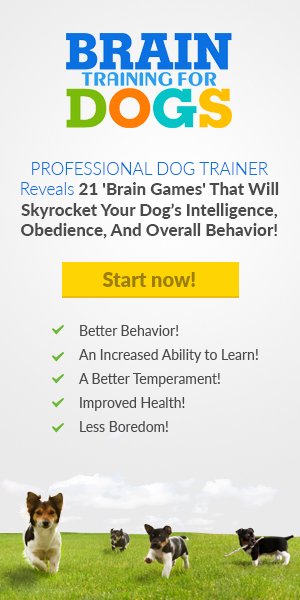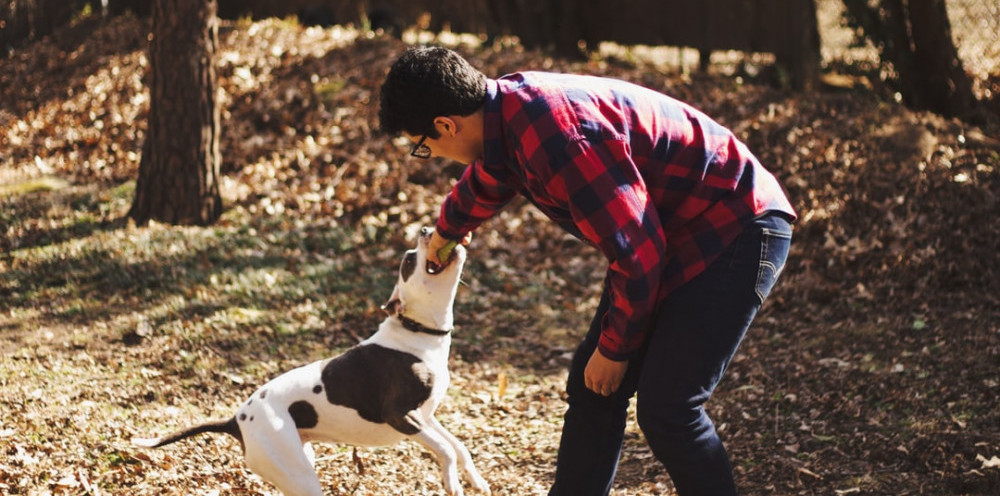TEACH YOUR DOG TO COME WHEN CALLED
I have been working with Cooper out in the yard. We were doing recall training–that is, working on getting him to come when called–and making a super fun game of it. It’s one of Cora’s most favorite games, she’s gotten good at it in the last year. Cooper, not so much. He is just all boy and has squirrel syndrome so bad!
So, I decided to pull my tips together in one post in case it helps anyone else who’s trying to teach your dog recall OR who’s struggling to troubleshoot a problem with your dog’s recall. If you would like professional help from a licensed dog trainer, click the banner on this page or here for Brain Training For Dogs!
GroomyDude.com is a participant in the Amazon Services LLC Associates Program, an affiliate advertising program designed to provide a means for sites to earn advertising fees by advertising and linking to amazon.com.
HOW TO TRAIN YOUR DOG TO COME
OK, let’s get super basic here: Teaching your dog to come when called is the most important thing he or she needs to learn for safety. If you’ve tried to teach recall and it didn’t stick, or if your dog knew it once and now doesn’t, or if you’re starting this out for the very first time, the process is the same.
First, pick a cue. Now, if you’re in the “didn’t stick” or “now doesn’t” camp, you need a word other than what you used previously. That word–probably “come”–is now dead to you. Pick something new. I’m a big, big fan of a specific whistle, but it doesn’t matter. Start by choosing your cue. For the sake of this post, I’m going to use “come,” but it can be anything short.
Next, watch your language! Don’t use that cue word for anything other than recall and never for anything negative. So, let’s say your dog is playing in the backyard and it’s time for his bath. Don’t call “Cooper, come!” and then drag him into the tub. From the moment you decide to train your dog to come, the recall word you chose can only be used for good things.
Third, set the bar really low. Start training recall in a distraction-free zone. Take your dog out to go to the bathroom first, then go somewhere quiet and comfortable like your living room. Get a friend or family member to help, and sit a few feet away from each other. Call your dog to come to you, dole out a valuable treat (this is NOT the time for dry, crunchy cookies, y’all), then have your friend do the same. Give lots of love and praise while you practice. With the bar still set low, move the game somewhere slightly more distracting–say, the backyard. Practice, practice, practice.
Don’t forget that distance is a degree of variability you need to practice, too. If you and your buddy stand 10 feet apart in the backyard, standing 15 feet apart is a nice, slight raise of that training bar.
Here’s something that works well to raise the bar ever so slightly: Once your dog masters the cue in the living room and the backyard, keep practicing with your friend as you increase the difficulty AND simultaneously you start working with your dog one-on-one back in the quiet/comfy spot. Let’s say you and your friend are working 10 feet apart in the backyard. That’s awesome! The next day, your friend isn’t available. So, you head into the living room with your treats and periodically call your dog to come and reward. Consider those activities two distinct parts of the training–your dog needs to reliably come to you when it’s you alone, but that’s much more difficult to manage in the early stages. So, work on both! But, again, keep the bar really super low so that you set your dog up to win.
Now, eventually, your home and your backyard will become too easy, and you’ll have to raise the bar again to, say, your front yard. Unless your front yard is fenced in, you NEED to put your dog on a long line (Like this one, we have an invisible fence). You are in training here, so it’s NOT the time to test your dog’s reliability.
Finally, keep at it. Training your dog to come when called is nothing like training your dog to sit in the sense that you need to work on recall all the time to reinforce it and to prove it, while a behavior like “sit” is naturally well integrated into your day and the stakes are low. Recall training should be ongoing. The cue should always stay positive, and you should practice every chance you get so that when you do find yourself needing it, your dog’s already an ace.
A QUICK ASIDE ABOUT TRAINING TREATS
Get the good ones. If you would like to read more on this check out this article.
Seriously, this isn’t biscuit time. This is freeze-dried liver time. This is squeeze cheese time. This is shredded chicken, turkey bacon, warmed-up hot dog time. Whatever is your dog’s go-to, can’t-resist, must-have treat, recall training is the time to use it. You don’t want your dog to think, “Eh, why bother? She just has that crappy dry cookie, and here I can eat rabbit poop,” or whatever it is. You know your dog’s preferences and tolerances, so pick the tippy-top of what he or she likes the best.
MAKE RECALL FUN!
What I am sharing is a game we call “Recall Relay.” my wife stands at one end of the yard, and I stand at the other. We both have a pile of treats, and we just call Coop back and forth. He loves it because he loves treats, he loves running, and he loves playing with us. It’s a win all around! As long as there are no squirrels!
We modify the game outside and inside, too, by adding in a hike-and-seek component. I’ll duck behind a shrub or behind the sofa and call Coop to come. He LOVES seeking us out, and finding us is almost as much of a reward to him as the actual treat we dish out.
Sometimes I’ll see him out in the yard doing nothing special, and I’ll grab a treat from his jar and call him to come–just for the fun of it and just for the reinforcement.
WHEN CAN I STOP USING TREATS? AND OTHER TROUBLESHOOTING TIPS…
“Ugh, my dog will only come because he knows I have treats.”
So?
I mean, truly, I only do my work because I know I’ll get paid. I’m not going to submit a bunch of copy to a client who might or might not compensate me… There’s nothing wrong with a rewards system, especially for behavior as important as come.
“My dog was so good at this, and now he ignores me.”
OK, so you’ve poisoned the cue. What that means is you’ve used “come” one too many times without payment or followed by something unpleasant or maybe it wasn’t as good as you thought it was, to begin with. The reason doesn’t actually matter, and the fix is (sorta) simple: Pick a new cue and start over. It’s far easier to train it as if it were a new behavior with a new cue word or whistle than it is to troubleshoot what went wrong with your old cue.
“He will come when called at home, but at the park… nada.”

You moved the bar too high too fast. Your dog needs to go back to recall boot camp with some purposeful retraining.
Also, know that a recall will never, ever be 100 percent. Let’s say you DO have it down pat at the park. Then, one day, there’s a deer standing in the middle of the field, and your dog has never seen a deer before, and your dog decides he reeeeeaallyyy needs to chase that animal… or, let’s say a stray cat darts across the street directly in front of you, and there’s nothing your dog loves more than chasing a stray cat… or, the ice cream truck hits a pothole and the whole giant tub of ice cream bounces out the back and splats on the sidewalk… or, whatever your dog finds truly irresistible. You can practice and prove and make it a game, and your dog might still ignore you in the face of something too good to be true.
It’s another topic for another post, but it’s one of the many reasons I strongly advocate for keeping your dog on a leash at all times unless you’re in a fenced-in yard or dog park. The recall is an emergencies-only cue, but the training is a fun, all-the-time thing.
TEACHING YOUR DOG TO COME WHEN CALLED IS WORTH THE EFFORT
You might be thinking that this sounds like a lot of effort. You might be thinking that this sounds like it takes an enormous amount of time.
You’re right. It is a lot of effort, and it does take a lot of time.
But it’s so worth it.
Twice in Cooper’s life, unforeseen circumstances resulted in him getting loose. The first time was at the beginning of training and he would not listen! The second was in public, we were on a trip and when I opened the door of the truck he barreled right past me in an instant in a full run.
In both cases, thank goodness, he came when I gave him the whistle.
We practice. We make it fun. And, when we need it, it works.
So, there you have it: My tips for how to teach your dog to come when called. Have you taught your dog a recall? How does he or she do? Have you encountered a need to use it? How do you prove the behavior? Please share in the comments so we can all learn from each other!
If you would like to have your coolest dog on the planet in the gallery on this site, fill out the form below and upload a pic with their name. There will be one lucky dog every month that gets picked for a cool little prize.






I feel that I lose my patience very quickly. I have been trying to teach my dog to come when I call him. But he seems to be in a world of his own. But I have arrived to the conclusion that there is no dog than can not be train. But that there are in fact many un trained humans that don’t know how to train their dogs. So, a huge thank you. Your post has given me the basics on where to start.
You are so right Abel!
There are those special dogs out there that just don’t have the capacity for specific things but for the most part, the general behavior is often picked up from the human they are dependent on. If one does not research and learn what they should be communicating and how with a dog, they will not be as successful.
I like the way you put it! Untrained people 🙂
Here is a cool little thing that can help! Karen Pryor Clicker Training
Thanks for stopping by!
Chad